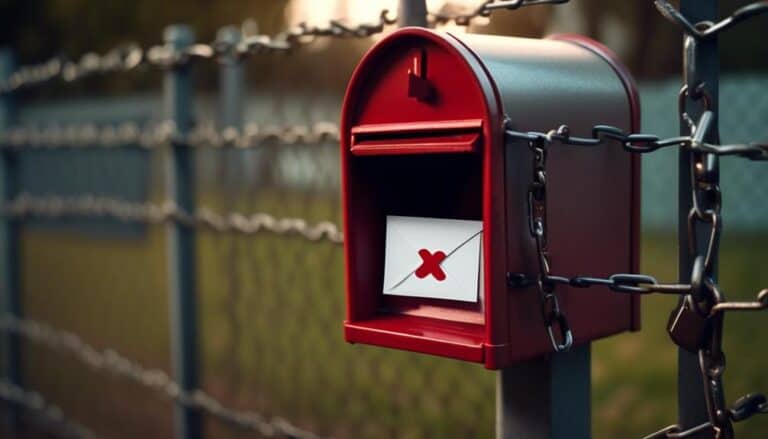Unlock the Secrets to Maintaining a Stellar Email Reputation
In today's digital landscape, having a stellar email reputation is crucial if you want to maximize your reach and engagement with your audience. It's no secret that maintaining a positive email reputation can greatly impact the success of your email campaigns.
But what are the secrets to unlocking this elusive achievement? How can you ensure that your emails consistently land in the inbox rather than the dreaded spam folder?
Well, buckle up, because in this discussion, we'll reveal the essential strategies and techniques that will help you maintain a stellar email reputation and take your email marketing game to new heights.
Key Takeaways
- Maintaining a stellar email reputation is crucial for email campaign success and reaching your marketing goals.
- Regularly clean your email list by removing inactive or unresponsive subscribers to improve email reputation.
- Personalize emails and deliver relevant and valuable content to improve engagement and reduce spam marking.
- Implement email authentication protocols (SPF, DKIM, DMARC) to prevent spoofing, enhance email security, and improve deliverability rates.
Importance of Email Reputation

Maintaining a stellar email reputation is crucial for ensuring the deliverability and effectiveness of your email campaigns. Your email reputation is a reflection of how recipients perceive your emails, and it can greatly impact your ability to reach your audience and achieve your marketing goals.
To effectively manage your email reputation, it's important to follow best practices for email reputation.
Email reputation management involves several key factors. First and foremost, you need to ensure that your email list consists of engaged and opted-in subscribers. This means obtaining permission from recipients before sending them emails and regularly cleaning your list by removing inactive or unresponsive subscribers.
Another important aspect of email reputation management is delivering relevant and valuable content to your subscribers. Sending emails that are personalized, timely, and tailored to the interests of your recipients can help improve engagement and reduce the likelihood of your emails being marked as spam.
It is also crucial to monitor and address any issues that may affect your email reputation. This includes promptly handling email bounces, complaints, and unsubscribe requests. Regularly monitoring your email deliverability rates and engagement metrics can provide insights into the health of your email reputation and help identify areas for improvement.
Understanding Email Deliverability
Now let's talk about understanding email deliverability.
This is an important aspect of maintaining a stellar email reputation.
Importance of Deliverability
Understanding email deliverability is crucial for maintaining a stellar email reputation and ensuring that your messages reach the intended recipients' inboxes.
Email deliverability refers to the ability of your emails to actually reach the recipients without being blocked or filtered as spam. It's influenced by various factors such as email engagement and inbox placement.
Email engagement measures how recipients interact with your emails, including opening, reading, and clicking on links. High email engagement indicates that your emails are valuable and relevant to your recipients, increasing the likelihood of inbox placement. On the other hand, low email engagement can negatively impact your deliverability, as it signals to email service providers that your messages are unwanted.
Factors Affecting Deliverability
To ensure optimal deliverability of your emails, it's important to be aware of the factors that can impact the likelihood of your messages reaching the intended recipients' inboxes.
Email deliverability challenges can arise from various sources, such as spam filters, blacklisting, and recipient engagement.
Spam filters are designed to identify and block unwanted emails, so it's crucial to follow best practices and avoid triggering these filters.
Being blacklisted can severely affect your email reputation and result in your messages being blocked or marked as spam.
Additionally, recipient engagement plays a significant role in deliverability. If your recipients aren't opening or engaging with your emails, email service providers may interpret this as a lack of interest and decrease the chances of your emails reaching the inbox.
Understanding these factors and taking proactive steps to maintain a stellar email reputation can have a direct impact on your marketing success.
Improving Email Deliverability
To improve the deliverability of your emails, it's crucial to understand the factors that impact whether your messages reach your recipients' inboxes. Here are four key strategies you can implement to enhance your email deliverability:
- Email Segmentation: Divide your email list into smaller, more targeted segments based on demographics, preferences, or behavior. This allows you to personalize your content and send more relevant emails to each group.
- Email Automation: Utilize automation tools to streamline your email marketing efforts. Set up automated email sequences to send timely and personalized messages to your subscribers. This helps maintain engagement and ensures your emails are delivered consistently.
- Maintain a Clean Email List: Regularly clean your email list by removing inactive or invalid email addresses. This helps improve deliverability by reducing the chances of your emails bouncing or being marked as spam.
- Monitor and Analyze Email Metrics: Keep a close eye on key email metrics such as open rates, click-through rates, and unsubscribe rates. Analyzing these metrics allows you to identify areas for improvement and make data-driven decisions to optimize your email campaigns.
Crafting Engaging and Relevant Content
Craft captivating and relevant email content to keep your audience engaged and interested. Personalization techniques and email segmentation are key to crafting content that resonates with your subscribers. By segmenting your email list based on demographics, preferences, and past interactions, you can tailor your content to meet the specific needs and interests of each segment.
Start by gathering data about your subscribers through sign-up forms, surveys, or tracking their interactions with your emails and website. This information will help you create targeted segments that allow for more personalized content delivery.
Once you have your segments in place, use personalization techniques to make your emails feel more tailored to each subscriber. Address them by their name in the subject line or introduction, and include relevant content based on their preferences or past purchases. This level of personalization shows your audience that you understand their needs and are committed to providing them with valuable content.
In addition to personalization, ensure that your content is engaging and relevant. Use concise and informative language to convey your message effectively. Incorporate storytelling techniques, visuals, and compelling calls-to-action to captivate your audience and encourage them to take action.
Building and Maintaining a Clean Email List

Maintaining a clean email list is essential for ensuring the deliverability and reputation of your emails. By following good email list hygiene practices, you can improve the quality of your email list and enhance your chances of reaching your target audience effectively.
Here are four key strategies to help you build and maintain a clean email list:
- Regularly clean your list: Remove inactive subscribers, invalid email addresses, and spam email addresses from your list. This will enhance the deliverability of your emails and improve your overall email reputation.
- Implement double opt-in: Require subscribers to confirm their email addresses before adding them to your list. This ensures that only engaged users who genuinely want to receive your emails are included, reducing the likelihood of spam complaints.
- Segment your list: Divide your subscribers into smaller, targeted segments based on their preferences, behaviors, or demographics. This allows you to send more personalized and relevant emails, increasing engagement and reducing the risk of unsubscribes.
- Provide easy unsubscribe options: Make it simple for subscribers to opt-out of your emails if they no longer wish to receive them. By offering a clear and hassle-free unsubscribe process, you can maintain a clean list and avoid spam complaints.
Implementing Proper Email Authentication
To protect your email reputation and ensure that your messages reach the intended recipients, it's crucial to implement proper email authentication.
Two key authentication methods are SPF (Sender Policy Framework) and DKIM (DomainKeys Identified Mail). SPF verifies that the sender of the email is authorized to send from a specific domain, while DKIM adds a digital signature to the email to verify its authenticity.
Additionally, implementing DMARC (Domain-based Message Authentication, Reporting, and Conformance) helps enforce email authentication policies and provides visibility into any unauthorized use of your domain.
SPF and DKIM
Implementing proper email authentication through SPF (Sender Policy Framework) and DKIM (DomainKeys Identified Mail) is essential for maintaining a stellar email reputation. These authentication methods verify the authenticity of the sender and ensure that emails aren't forged or tampered with.
By implementing SPF and DKIM in your email security, you can enjoy a range of benefits, including:
- Improved deliverability: SPF and DKIM help prevent your emails from being marked as spam or rejected by recipient servers.
- Enhanced security: These authentication methods add an extra layer of protection against phishing attacks and email spoofing.
- Brand reputation preservation: By using SPF and DKIM, you can protect your brand's reputation by ensuring that your emails are trusted and authentic.
- Increased email engagement: With proper email authentication, your recipients can have confidence in the legitimacy of your emails, leading to higher open and click-through rates.
DMARC Implementation
With SPF and DKIM in place, it's now time to take your email authentication to the next level by implementing DMARC. DMARC, which stands for Domain-based Message Authentication, Reporting, and Conformance, provides an additional layer of security by allowing senders to specify how their emails should be handled if they fail authentication checks. By implementing DMARC, you can enjoy several benefits, such as improved deliverability, increased email trustworthiness, and protection against email spoofing and phishing attacks.
However, implementing DMARC also comes with its challenges. It requires technical knowledge and expertise to properly configure and manage the DMARC record. Additionally, it may take time to gradually implement DMARC policies to prevent legitimate emails from being falsely flagged as fraudulent.
To help you understand the benefits and challenges of DMARC implementation, take a look at the table below:
| DMARC Implementation Benefits | DMARC Implementation Challenges |
|---|---|
| Improved deliverability | Technical complexity |
| Increased email trustworthiness | Time-consuming process |
| Protection against email spoofing and phishing attacks | Gradual policy implementation |
Managing Unsubscribes and Complaints

Are you wondering how to effectively manage unsubscribes and complaints while maintaining a stellar email reputation? It's important to handle these situations with care to ensure that your email deliverability remains high and that your recipients continue to view your emails as valuable.
Here are some strategies to help you manage unsubscribes and complaints:
- Provide a clear and easy-to-use unsubscribe option in all your emails. This allows recipients to opt out if they no longer desire to receive your emails, reducing the risk of them marking your emails as spam.
- Monitor and analyze your bounce rates regularly. High bounce rates can negatively impact your email reputation, so it's crucial to clean your email list and remove invalid email addresses promptly.
- Actively address complaints and feedback from recipients. Responding promptly and professionally can help resolve any issues and prevent them from escalating.
- Use feedback loops provided by ISPs to monitor complaints. This allows you to identify any recurring issues and take appropriate actions to improve your email practices.
Monitoring and Analyzing Email Performance
To maintain a stellar email reputation, it's essential to continually monitor and analyze the performance of your emails. Email performance analysis allows you to gain valuable insights into how your emails are performing and make data-driven decisions to improve your campaigns. By monitoring key metrics such as open rates, click-through rates, and conversion rates, you can identify trends and patterns to optimize your email marketing strategy.
One of the most important email monitoring strategies is tracking your deliverability rates. This metric measures the percentage of emails that successfully reach your subscribers' inboxes. By closely monitoring your deliverability rates, you can identify any issues that may be affecting your email deliverability and take immediate action to rectify them.
Another crucial aspect of email performance analysis is analyzing engagement metrics. This includes metrics such as click-through rates, bounce rates, and unsubscribe rates. By carefully examining these metrics, you can gauge the effectiveness of your email content, subject lines, and call-to-action buttons. If you notice a decline in engagement, you can experiment with different elements to improve your email performance.
In addition to monitoring metrics, it's also essential to analyze the feedback you receive from your subscribers. Pay attention to any complaints or unsubscribes and take them as an opportunity to improve your email content and address any issues.
Avoiding Common Email Reputation Pitfalls

To maintain a stellar email reputation, it's crucial to steer clear of common pitfalls that can harm your deliverability and engagement rates. Avoiding these mistakes will help you build trust with your recipients and ensure that your emails land in their inbox, rather than the dreaded spam folder.
Here are some best practices for email reputation that you should keep in mind:
- Avoid using misleading subject lines: Your subject line should accurately reflect the content of your email. Misleading subject lines can lead to high unsubscribe rates and damage your reputation.
- Regularly clean your email list: Remove inactive or bouncing email addresses from your list to maintain a healthy sender reputation. Sending emails to invalid addresses can result in high bounce rates and negatively impact your deliverability.
- Personalize your emails: Sending generic emails that lack personalization can make your recipients feel disconnected. Tailor your messages to your audience to increase engagement and improve your email reputation.
- Respect your subscribers' preferences: Honor unsubscribe requests promptly and respect your subscribers' preferences regarding email frequency. By doing so, you'll demonstrate that you value their privacy and build trust with your audience.
Staying Compliant With Email Regulations
Staying compliant with email regulations is essential for maintaining a stellar email reputation and ensuring that your messages reach your recipients' inboxes. Email compliance refers to adhering to legal regulations and guidelines set by various governing bodies, such as the CAN-SPAM Act in the United States and the GDPR in the European Union.
To stay compliant, it's crucial to obtain explicit permission from your recipients before sending them any marketing emails. This can be done through opt-in forms on your website or by requesting consent during the registration process. Additionally, you must include an unsubscribe link in every email, allowing recipients to opt out of future communications.
Legal regulations also require you to provide accurate and truthful information in your emails, including your contact information and subject lines that accurately reflect the content of the message. Misleading or deceptive practices can lead to penalties and damage to your email reputation.
Regularly reviewing and updating your email compliance practices is essential to ensure ongoing adherence to legal regulations. By staying compliant, you not only avoid legal issues but also build trust with your recipients, enhancing your email reputation and increasing the chances of your messages reaching the intended audience's inbox.
Continuously Improving Email Reputation

Now let's focus on improving your email reputation by implementing strategies that will enhance your overall sender reputation. Continuous monitoring and reputation management are crucial for maintaining a stellar email reputation.
Here are some key strategies to help you continuously improve your email reputation:
- Consistently monitor your email deliverability rates and sender score to identify any dips or issues that need to be addressed promptly.
- Regularly review and update your email list to ensure that you're sending emails to engaged and active recipients. Remove any inactive or unengaged subscribers to maintain a high-quality list.
- Implement authentication protocols such as SPF (Sender Policy Framework), DKIM (DomainKeys Identified Mail), and DMARC (Domain-based Message Authentication, Reporting, and Conformance) to verify your email domain and protect against spoofing and phishing attempts.
- Personalize your email content and segment your audience to deliver more relevant and targeted messages. This will increase engagement and decrease the chances of your emails being marked as spam.
Frequently Asked Questions
How Often Should I Update My Email Contact List?
You should update your email contact list regularly to ensure optimal email deliverability. This helps with email list management and maintaining a stellar email reputation. Keep it fresh to stay connected and boost engagement.
What Are the Consequences of Not Properly Authenticating My Emails?
Not properly authenticating your emails can lead to negative consequences such as poor email deliverability and damage to your email reputation. Following email authentication best practices is crucial for maintaining a stellar email reputation.
Can I Send Promotional Emails to People Who Haven't Subscribed to My List?
Sending promotional emails to people who haven't subscribed to your list is not recommended. It goes against email etiquette and can have legal implications. It's important to build a list of engaged subscribers who are interested in your offerings.
How Can I Measure the Success of My Email Campaigns?
To measure the success of your email campaigns, track key metrics like open rates, click-through rates, and conversion rates. Use best practices for email campaign tracking, such as segmenting your audience and testing different subject lines and content.
What Are the Most Common Mistakes That Harm Email Reputation?
Avoiding common mistakes that harm email reputation is crucial for maintaining a high Sender Score and good email deliverability. Keep your list clean, send relevant content, and monitor your metrics regularly to ensure success.
Conclusion
False








